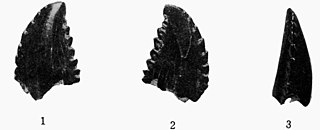
Characidae, the characids or characins is a family of freshwater subtropical and tropical fish, belonging to the order Characiformes. The name "characins" is the historical one, but scientists today tend to prefer "characids" to reflect their status as a by and large monophyletic group at family rank. To arrive there, this family has undergone much systematic and taxonomic change. Among those fishes that remain in the Characidae for the time being are the tetras, comprising the very similar genera Hemigrammus and Hyphessobrycon, as well as a few related forms such as the cave and neon tetras. Fish of this family are important as food and also include popular aquarium fish species.

The neon tetra is a Freshwater fish of the characin family of order Characiformes. The type species of its genus, it is native to blackwater and clearwater streams in the Amazon basin of South America. Its bright colouring makes the fish visible to conspecifics in the dark blackwater streams, and is also the main reason for its popularity among freshwater fish hobbyists, with neon tetras being one of the most widely kept tropical fish in the world.

Troodon is a former wastebasket taxon and a potentially dubious genus of relatively small, bird-like theropod dinosaurs definitively known from the Campanian age of the Late Cretaceous period. It includes at least one species, Troodon formosus, known from Montana. Discovered in October 1855, T. formosus was among the first dinosaurs found in North America, although it was thought to be a lizard until 1877. Several well-known troodontid specimens from the Dinosaur Park Formation in Alberta were once believed to be members of this genus. However, recent analyses in 2017 have found this genus to be undiagnostic and referred some of these specimens to the genus Stenonychosaurus some to the genus Latenivenatrix, and some to the genus Pectinodon. The genus name is Ancient Greek for "wounding tooth", referring to the teeth, which were different from those of most other theropods known at the time of their discovery. The teeth bear prominent, apically oriented serrations. These "wounding" serrations, however, are morphometrically more similar to those of herbivorous reptiles, and suggest a possibly omnivorous diet.

Tetra is the common name of many small freshwater characiform fishes. Tetras come from Africa, Central America, and South America, belonging to the biological family Characidae and to its former subfamilies Alestidae and Lebiasinidae. The Characidae are distinguished from other fish by the presence of a small adipose fin between the dorsal and caudal fins. Many of these, such as the neon tetra, are brightly colored and easy to keep in captivity. Consequently, they are extremely popular for home aquaria.

Hyphessobrycon is a genus of freshwater fish in the family Characidae. These species are among the fishes known as tetras. The genus is distributed in the Neotropical realm from southern Mexico to Río de la Plata in Argentina. Many of these species are native to South America; about six species are from Central America and a single species, H. compressus is from southern Mexico.
Tetra Laval is a Swiss-domiciled multinational corporation of Swedish origin, with headquarters in Pully (Vaud), Switzerland. The Tetra Laval Group provides packaging, processing and distribution products for a range of foodstuffs, including liquids, fruit and vegetables, ice-cream and processed food, additionally offering systems for agricultural production and herd management. The group operates in five business segments: milk production, food preparation, food processing, food packaging and food distribution. The Tetra Laval Group includes Tetra Pak, DeLaval and Sidel. Tetra Laval was included in the Thomson Reuters 2011 list of Top 100 Global Innovators.

Tetra Brik is a brand name for a carton package produced by the Swedish packaging company Tetra Pak. Its shape is cubic or cuboid, and it is available with or without various different caps. The Tetra Brik is the best-known and most sold package in the Tetra Pak packaging family, to the extent that Tetra Brik is sometimes mistaken for the brand name. The Tetra Brik comes in either chilled or ambient package types.

Saurornithoides is a genus of troodontid maniraptoran dinosaur, which lived during the Late Cretaceous period. These creatures were predators, which could run fast on their hind legs and had excellent sight and hearing. The name is derived from the Greek stems saur~ (lizard), ornith~ (bird) and eides (form), referring to its bird-like skull.

Amelia is the birth defect of lacking one or more limbs. The term may be modified to indicate the number of legs or arms missing at birth, such as tetra-amelia for the absence of all four limbs. The term is from Greek ἀ- 'lack of' plus μέλος 'limb'.

Tetra Pak is a multinational food packaging and processing company headquartered in Switzerland. The company offers packaging, filling machines and processing for dairy, beverages, cheese, ice cream and prepared food, including distribution tools like accumulators, cap applicators, conveyors, crate packers, film wrappers, line controllers and straw applicators.

Glandulocaudinae are a subfamily of tropical freshwater characin fish from Central and South America. In all species of this subfamily, a gland on their caudal fin is found almost exclusively in the males, which allows the release and pumping of pheromones; also, members of this subfamily have complex courtship behaviors which lead to insemination. The ecology and life history of these fish is complex yet little studied. Glandulocaudines are important as food fish for larger fish important for commercial and subsistence reasons.
George Sprague Myers was an American ichthyologist who spent most of his career at Stanford University. He served as the editor of Stanford Ichthyological Bulletin as well as president of the American Society of Ichthyologists and Herpetologists. Myers was also head of the Division of Fishes at the United States National Museum, and held a position as an ichthyologist for the United States Fish and Wildlife Service. He was also an advisor in fisheries and ichthyology to the Brazilian Government.
Mimagoniates microlepis, also known as the blue tetra, the croaking tetra, the small-scaled tetra, is a species of tetra in the genus Mimagoniates. First identified by Franz Steindachner in 1876 and named Coelurichthys microlepis, it has also been identified as Coelurichthys iporangae, Coelurichthys lateralis, and Mimagoniates iporangae besides its current taxonomic classification. There is evidence of a variety called M. microlepis 'Joinville' which might be synonymous with Paragoniates microlepis.
Blue tetra is a common name for species of tetra including:
Mimagoniates is a genus of characid fish from rivers and streams in southeastern, southern and central-western Brazil, northeastern Argentina, and Paraguay. The individual species generally have relatively small ranges and two, M. lateralis and M. sylvicola, are considered threatened by Brazil's Ministry of the Environment.
Mimagoniates inequalis, known as the croaking tetra, is a species of tetra in the genus Mimagoniates. It was previously classified as Glandulocauda inequalis
Tetra Cave Natural Monument is a karst cave 1.6 km northwest of Tskaltubo in Tskaltubo Municipality in Imereti region of Georgia. Locally known as White Cave it is located 140 meters above sea level.
Osmocom is an open-source software project that implements multiple mobile communication standards, including GSM, DECT, TETRA and others.








